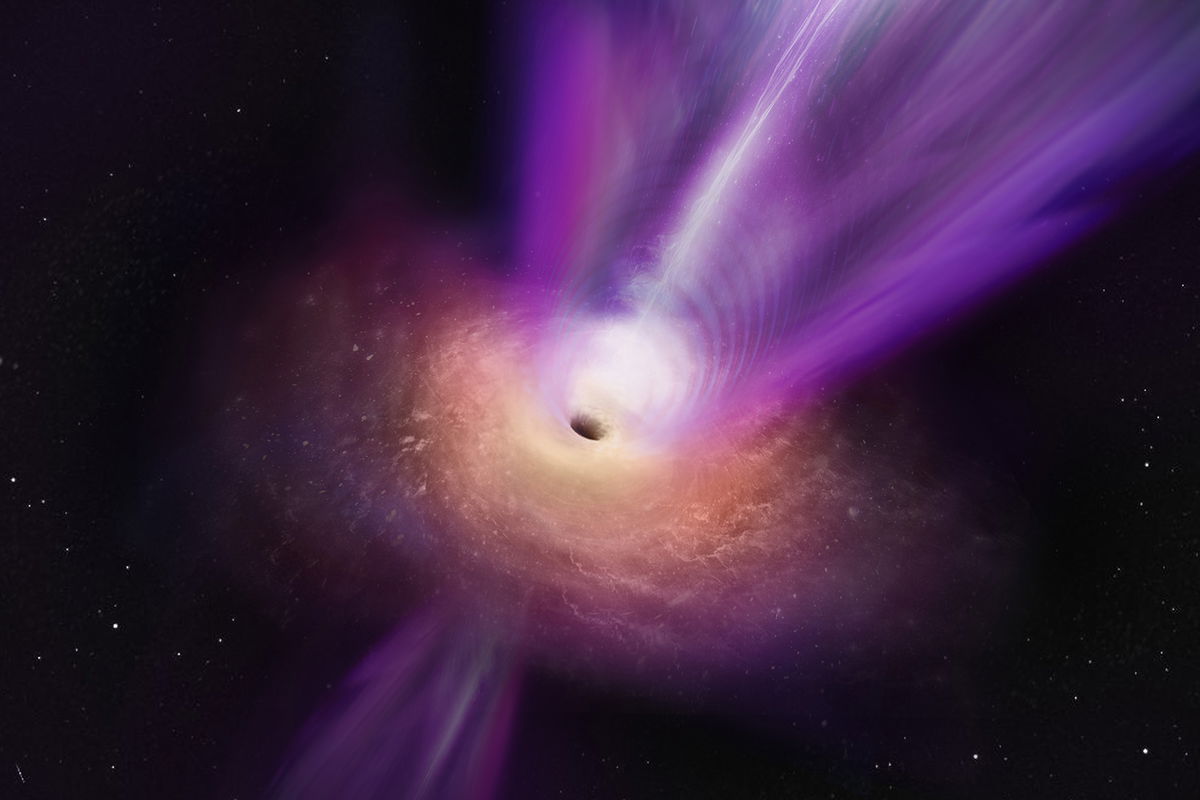New first-of-its-kind image reveals a jet of material launching from a black hole

An artist's concept shows how the black hole's massive jet rises up from the center.
By Ashley Strickland, CNN
Astronomers have captured for the first time the shadow of a black hole and the powerful jet of material emerging from it in a newly released image.
The supermassive black hole is at the center of the galaxy Messier 87, or M87. The observations were initially made in 2018 by combining the capabilities of multiple telescopes.
The groundbreaking image can help astronomers gain more insight into how black holes behave and what enables them to launch energetic jets of material across the universe.
The Atacama Large Millimeter/submillimeter Array in Chile, the Greenland Telescope and the Global Millimetre VLBI Array of telescopes across Europe and North America worked together to create a virtual Earth-size telescope and peer into the heart of M87, located 55 million light-years away.
The black hole at M87’s galactic center is 6.5 billion times more massive than the sun.
A large galaxy usually contains a supermassive black hole at its center, where the celestial object gobbles up gas, dust and stars that pass too closely. But a black hole can also send powerful jets of material blasting across space and beyond its home galaxy.
The new image and an accompanying research paper were published Wednesday in the journal Nature.
“We know that jets are ejected from the region surrounding black holes, but we still do not fully understand how this actually happens. To study this directly we need to observe the origin of the jet as close as possible to the black hole,” said lead study author Ru-Sen Lu, astronomer at the Shanghai Astronomical Observatory in China, in a statement.
In the new image, the connection between the base of the jet and the matter swirling around the supermassive black hole can be seen. Previous observations have shown the jet and black hole separately, including the first direct image of a black hole, released in 2019.
“This new image completes the picture by showing the region around the black hole and the jet at the same time,” said study coauthor Jae-Young Kim, assistant professor at Kyungpook National University in South Korea, in a statement.
As matter orbits around the black hole, it heats up and releases radiation in wavelengths of light. The light creates the ring structure seen glowing around the black hole’s shadow, or the darkness at the center. The new image captured radio light emitted at a longer wavelength than the 2019 image.
“At this wavelength, we can see how the jet emerges from the ring of emission around the central supermassive black hole,” said study coauthor Thomas Krichbaum, a research fellow at the Max Planck Institute for Radio Astronomy, in a statement.
The size of the ring in the new image is about 50% larger when compared with the 2019 image taken by the Event Horizon Telescope Collaboration, another global network of telescopes used in photographing the M87 black hole. Astronomers believe that more material is falling toward the black hole in the new image, which is why the ring looks bigger.
The researchers used interferometry, a technique that synchronizes the signals captured by each telescope, to create the image.
Studying black holes
Recently, astronomers also used machine learning to release a cleaner, sharper version of the original M87 black hole image from 2019.
The central region is darker and larger, surrounded by a bright ring as hot gas falls into the black hole.
Black holes are made up of huge amounts of matter squeezed into a small area, according to NASA, creating a massive gravitational field that draws in everything around it, including light. These powerful celestial phenomena also have a way of superheating the material around them and warping space-time.
Material accumulates around black holes, is heated to billions of degrees and reaches nearly the speed of light. Light bends around the gravity of the black hole, which creates the photon ring seen in the image. The black hole’s shadow is represented by the dark central region.
The visual confirmation of black holes also acts as confirmation of Albert Einstein’s theory of general relativity. In the theory, Einstein predicted that dense, compact regions of space would have such intense gravity that nothing could escape them. But if heated materials in the form of plasma surround the black hole and emit light, the event horizon could be visible.
More observations from global telescope networks could help unravel other secrets about black holes.
“We plan to observe the region around the black hole at the centre of M87 at different radio wavelengths to further study the emission of the jet,” said study coauthor Eduardo Ros, scientific coordinator of the department for very long baseline interferometry at the Max Planck Institute for Radio Astronomy, in a statement. “The coming years will be exciting, as we will be able to learn more about what happens near one of the most mysterious regions in the Universe.”
The-CNN-Wire
™ & © 2023 Cable News Network, Inc., a Warner Bros. Discovery Company. All rights reserved.

